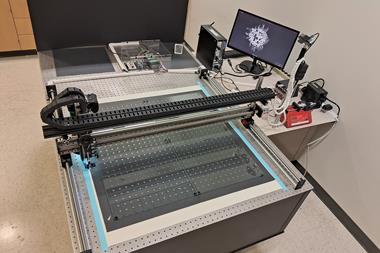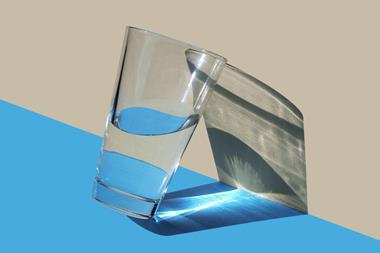Any substance with both gas and liquid phases has a liquid–gas critical point – a specific pressure and temperature at which they become indistinguishable. In recent years, scientists have also proposed that critical points in which both phases are liquids could explain the bizarre properties of substances such as water, but such a liquid–liquid critical point has never been directly observed. Now, however, researchers in France studying sulfur have produced the first experimental evidence for a liquid–liquid critical point in any substance.1
Water has numerous weird properties – the most well known being its decrease in density on freezing – and these become more pronounced at low temperatures. In 1992, Eugene Stanley and colleagues at Boston University in the US used computer modelling to explain these oddities, postulating that water at ambient conditions contains two distinct molecular structures.2 As water is cooled towards its liquid–liquid critical point at around 173K, they suggested correlations between the structures become more pronounced and, at the critical point, water would phase separate into a milky mixture of the two – a phenomenon called critical opalescence. Unfortunately, cooling water to 173K without it simply freezing has not yet been achieved. Liquid–liquid critical points have also been predicted theoretically in elements such as hydrogen and nitrogen, but never at readily accessible pressures and temperatures.
A liquid–liquid phase transition has been unambiguously demonstrated in sulfur’s neighbour in the periodic table: phosphorus. Models suggest this phase transition should terminate at a critical point at around 4000K: ‘To contain a reactive material at those high temperatures and make quantitative measurements requires technical developments that are currently not available,’ explains Mohamed Mezouar of the European Synchrotron Radiation Facility in France.
Mezouar and colleagues suspected sulfur could also exist in two liquid forms and would reach such a critical point. Computer modelling of liquid sulfur is extremely difficult; however, it undergoes another, poorly-understood phase transition when heated at room temperature from a purely molecular state to a complex mixture of molecules and polymer chains. ‘As there were no predictions for the liquid–liquid transition, there were no predictions for the liquid–liquid critical point,’ says Mezouar. The researchers found that, below about 1,035K, increasing the applied pressure beyond a given point caused a sudden drop in the pressure of the sample, implying a sudden change to a high density phase, whereas above this temperature no such pressure drop occurred: ‘We actually believe that we passed directly on the critical point because we saw an anomaly that showed some deformation we could interpret as the equivalent of the opalescence effect.’
‘The experiments are beautiful,’ says Francesco Sciortino of Sapienza University of Rome, Italy, part of Eugene Stanley’s team in 1992. He says only small-angle diffraction measurements showing critical opalescence, however, can conclusively prove the existence of a critical point: ‘The liquid–liquid transition is there. The liquid–liquid critical point is 99.9% there. I wouldn’t say they’ve seen it because they didn’t do the experiment to see it. But now they know more or less where the critical point is they can do a fine experiment to detect the critical fluctuations, and I’m sure they will do it.’
References
1 L Henry et al, Nature, 2020, 584, 382 (DOI: 10.1038/s41586-020-2593-1)
2 P Poole et al, Nature, 1992, 360, 324 (DOI: 10.1038/360324a0)






















No comments yet